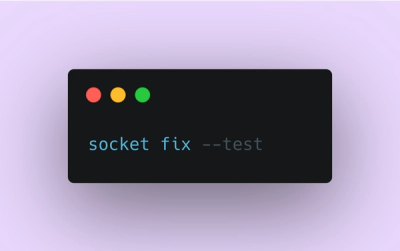
Product
Introducing Socket Fix for Safe, Automated Dependency Upgrades
Automatically fix and test dependency updates with socket fix—a new CLI tool that turns CVE alerts into safe, automated upgrades.
A markdown to custom components library. Supports any virtual DOM library.
npm install marksy
import React, {createElement} from 'React';
import marksy from 'marksy'
// const marksy = require('marksy').marksy
const compile = marksy({
// Pass in whatever creates elements for your
// virtual DOM library. h('h1', {})
createElement,
// You can override the default elements with
// custom VDOM trees
elements: {
h1 ({id, children}) {
return <h1 className="my-custom-class">{children}</h1>
},
h2 ({id, children}) {},
h3 ({id, children}) {},
h4 ({id, children}) {},
blockquote ({children}) {},
hr () {},
ol ({children}) {},
ul ({children}) {},
p ({children}) {},
table ({children}) {},
thead ({children}) {},
tbody ({children}) {},
tr ({children}) {},
th ({children}) {},
td ({children}) {},
a ({href, title, target, children}) {},
strong ({children}) {},
em ({children}) {},
br () {},
del ({children}) {},
img ({src, alt}) {},
code ({language, code}) {},
codespan ({children}) {},
},
});
const compiled = compile('# hello', {
// Options passed to "marked" (https://www.npmjs.com/package/marked)
});
compiled.tree // The React tree of components
compiled.toc // The table of contents, based on usage of headers
You can also add your own custom components. You do this by importing marksy/jsx. This build of marksy includes babel transpiler which will convert any HTML to elements and allow for custom components:
import React, {createElement} from 'react'
import marksy from 'marksy'
const compile = marksy({
createElement,
components: {
MyCustomComponent (props) {
return <h1>{props.children}</h1>
}
}
})
/* CREATE MARKDOWN USING MARKSY LANGUAGE:
# Just a test
```marksy
h(MyCustomComponent, {}, "Some text")
```
*/
This will be converted to the component above. You can pass in any kind of props, as if it was normal code. If you are not familiar with h, this is a convention for creating elements and components in virtual dom implementations.
You can take one step further and create components wherever you want in the markdown, using jsx. You will have to import marksy/jsx. This build of marksy includes babel transpiler which will convert any HTML to elements and allow for custom components. Note that this will increase your bundle size sagnificantly:
import React, {createElement} from 'react'
import marksy from 'marksy/jsx'
const compile = marksy({
createElement,
components: {
MyCustomComponent (props) {
return <h1>{props.children}</h1>
}
}
})
/* MARKDOWN:
# Just a test
<MyCustomComponent>some text</MyCustomComponent>
*/
/* WITH LANGUAGE FOR GENERIC SUPPORT:
# Just a test
```marksy
<MyCustomComponent>some text</MyCustomComponent>
```
*/
You might need to pass in general information to your custom elements and components. You can pass in a context to do so:
import React, {createElement} from 'react'
import marksy from 'marksy/jsx'
const compile = marksy({
createElement,
elements: {
h1(props) {
return <h1>{props.context.foo}</h1>
}
},
components: {
MyCustomComponent (props) {
return <h1>{props.context.foo}</h1>
}
}
})
compile('<MyCustomComponent />', null, {
foo: 'bar'
})
To enable code highlighting you just need to add a method that does the transformation. Here is an example with Highlight.js, but you could also use Prism. Both of them support server side rendering. For example:
import {createElement} from 'react'
import 'highlight.js/styles/github.css';
import hljs from 'highlight.js/lib/highlight';
import hljsJavascript from 'highlight.js/lib/languages/javascript';
import marksy from 'marksy/jsx'
hljs.registerLanguage('javascript', hljsJavascript);
const compile = marksy({
createElement,
highlight(language, code) {
return hljs.highlight(language, code).value
}
})
The elements returned is:
<pre>
<code class="language-js">
...code...
</code>
</pre>
Meaning that the code element is added a classname based on the language.
yarn installyarn start -> localhost:8080 (development app)FAQs
Convert markdown into react components
The npm package marksy receives a total of 66,449 weekly downloads. As such, marksy popularity was classified as popular.
We found that marksy demonstrated a not healthy version release cadence and project activity because the last version was released a year ago. It has 3 open source maintainers collaborating on the project.
Did you know?

Socket for GitHub automatically highlights issues in each pull request and monitors the health of all your open source dependencies. Discover the contents of your packages and block harmful activity before you install or update your dependencies.

Product
Automatically fix and test dependency updates with socket fix—a new CLI tool that turns CVE alerts into safe, automated upgrades.

Security News
CISA denies CVE funding issues amid backlash over a new CVE foundation formed by board members, raising concerns about transparency and program governance.

Product
We’re excited to announce a powerful new capability in Socket: historical data and enhanced analytics.